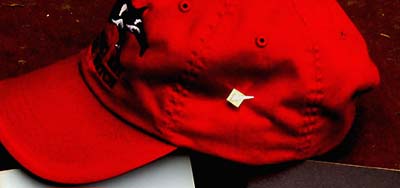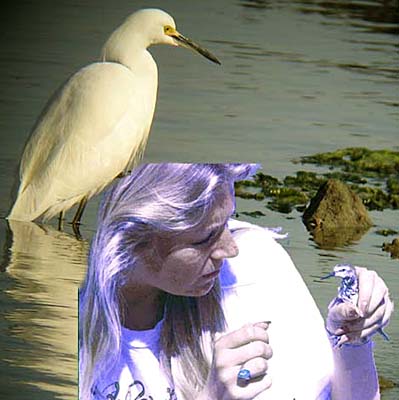 TICKY
TOKENS TICKY
TOKENS
In the early 1980s, after the death of Bob Smart, an ebullient New Hampshire
birder who was a founder of the American Birding Association, an anonymous
group decided to honor Bob Smart by awarding "Ticky Tokens" for birding
accomplishments. These were awarded nationally but without publicity of
any kind. Rather, one day the receiver would simply find a gold pin, shaped
like a check mark [in birding lingo, a "tick" on your checklist — on the
red cap, right], in his or her mailbox, with a short note describing what
it was and why it was awarded. As far as I know, those who made these awards
were never revealed. Yet, in many ways, they did acknowledge certain achievements
of value to the birding community. For example, in California, Joe Morlan
received the award for writing his important identification paper on White/Black-backed
Wagtails [Continental Birdlife 2: 37-50]. Awards were also made
for bird listing: Don Roberson received for organizing the California team
that set a new ABA record for a Big Day. A number of other Californians
also received this anonymous award.
|
| 'OFFICIAL' BIRD NAMES
In the mid to late 1970s, hardore California birders imported a social custom that originated in Texas. The story may now be somewhat apocryphal, but it is said that Edger Kinkaid, an irascible older gentleman and a good observer who liked birds a lot more than he liked people, bestowed 'bird names' on the few local birders that he found worthy. Rose Ann Rowlett, for example, was given the monkier "Western Grebe" and has been known to friends as "The Grebe" to this day. Kinkaid called himself "The Cassowary," for the only bird known to kill people [i.e., legendary stories of cassowaries disembowling native hunters who tried to trap them]. Or so it was said. John Luther had associations with Texas birders and was bestowed the name "Aplomado Falcon." In due course, an informal group of hardcore California birders determined they would set up an "official" committee to give worthy California birders an "official" bird name. To be "worthy," one had to be an active State birder who participated, at least to some extent, in the birding social scene, such as doing the "Death Valley loop" for days during Memorial Day weekend, or during the fall weekends. Several very important California birders never received names because they did not attend these social birding events (e.g., Alan Craig, Gene Cardiff, Alan Baldridge). One had to put in a certain number of years of this dedication and, after that, it was up to the whim of the committee to develop a name. Names were not necessarily limited to American species, and several California birders received Mexican bird names [and a couple received monikers that were not bird names at all.]
There were 'official' bird names and then nicknames for the bird names. Donna Dittmann was formally named the "Snowy Egret," but everyone called her the "Icy Egret," somewhat a play on words, given her bubbly personality. Even if you never met Donna, perhaps you can see some of the resemblance that the committee saw in the collage (left). In any event, names were bestowed for about a five year period, and then the committee disbanded. More recent efforts have not succeeded, possibly because these efforts have violated the basic rule that one must first (a) be worthy of a bird name and then (b) have nothing to do with its choice. They were one way in which the short-lived birding culture of the 1970s honored their own. A few of those who received names also were given embroidered shirts with "their" bird, hand-woven by several of the women in the birding world at that time. And there was once a Halloween Party on the Furnace Creek golf course where birders were supposed to come customed as their bird name — and many did. |
Among those who did receive "official" bird names are these (alphabetically):
|
| Quite apart from the "official" bird names bestowed by committee, one important birder formally renamed herself through the court system. Debra Love Milichap, who was first known to birders in the mid-1970s by her prior married name of Debi Robinson, became Debra Love Shearwater, known to all since as Debi Shearwater. That name actually IS legal. Everything else on this page is strictly "official" from the narrow perspective of the birding subculture only. |
 It
was also of absolute importance that the receiver could not influence or
have anything to do with the choice of their name. If one expressed a preference,
that potential name was ruled out. Equally important, the bird name chosen
had to "fit" the person who received it. While the receiver was never told
the reason they were given a particular name, the ideal name was one that
when folks heard what it was, they would say "ah, that makes sense. ..
a perfect fit!" Many (but not all) were slightly sarcastic. It could
be a name that suggested something about the receiver's physique, or personality,
or birding habits, or status. Guy McCaskie was named the "Magnificant Frigatebird"
and Rich Stallcup the "Great Curassow;" obviously recognizing status but
also, in Rich's case, finding a good parallel between the curassow's crest
and Rich's unruly and abundant hair. Laurie Binford often dressed in subdued
gray, and often bemoaned that there were no good birds around; he became
the "Grayish Mourner." Several other birders received somewhat similar
names for (presumably) somewhat similar traits. In contrast, everyone thought
Brad Schram would make a great game show host for his looks and voice,
and he became "The Master of Ceremonies" [one of two 'non-bird' names bestowed].
There was, indeed, a ceremony involved in receiving a bird name, and in
the late 1970s Brad would preside over these, usually at night around a
desert campfire.
It
was also of absolute importance that the receiver could not influence or
have anything to do with the choice of their name. If one expressed a preference,
that potential name was ruled out. Equally important, the bird name chosen
had to "fit" the person who received it. While the receiver was never told
the reason they were given a particular name, the ideal name was one that
when folks heard what it was, they would say "ah, that makes sense. ..
a perfect fit!" Many (but not all) were slightly sarcastic. It could
be a name that suggested something about the receiver's physique, or personality,
or birding habits, or status. Guy McCaskie was named the "Magnificant Frigatebird"
and Rich Stallcup the "Great Curassow;" obviously recognizing status but
also, in Rich's case, finding a good parallel between the curassow's crest
and Rich's unruly and abundant hair. Laurie Binford often dressed in subdued
gray, and often bemoaned that there were no good birds around; he became
the "Grayish Mourner." Several other birders received somewhat similar
names for (presumably) somewhat similar traits. In contrast, everyone thought
Brad Schram would make a great game show host for his looks and voice,
and he became "The Master of Ceremonies" [one of two 'non-bird' names bestowed].
There was, indeed, a ceremony involved in receiving a bird name, and in
the late 1970s Brad would preside over these, usually at night around a
desert campfire.